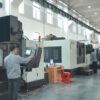The assembly process of industrial robots is determined by the structural design. There is no error-proofing in the product design, which is the root cause of the quality problem of incorrect assembly. Error proofing from the design can fundamentally solve the problem. Keyanng’s engineering team, after years of experience in parts manufacturing, has summed up 10 assembly-oriented design rules to reduce the difficulty of assembly operations and improve assembly efficiency and accuracy.
- Reduce the number of parts
Each part increases the chance of assembly errors, so use composite parts when designing, such as electronic housings that use living hinges instead of knuckle hinges. Or choose 3D printing or mold forming. For example, General Electric used 3D printing to reduce the 800 parts on the engine to 12, and Tesla reduced 70 parts to 1 part through the super die casting machine.
- Built-in fasteners
Avoid screws and design the assembly directly into the part where possible, or opt for a snap-fit design that can be assembled without tools. One caveat: Snap-fits can add to injection mold costs, so be sure to design your parts to be injection-friendly.
- Use standard parts
Standard parts are commonly used in the industry and are produced by professional factories, with low manufacturing costs and convenient procurement. When the products are worn out, the parts can be replaced directly. Using standard parts also reduces the labor-intensive design effort, allowing you to focus on product innovation.
- Minimize variance
Reduce part variety by using the same parts across the entire design and product range. As summing a robot assembly, 3 different sizes of screws are used: M5 x 10 mm socket head cap screws, M4 x 10 mm socket cap screws, and M4 x 10 mm hex head screws.
This is a very bad design; the parts are not interchangeable. It is easy to confuse the installation position of the screws, the assembly tools need to be changed frequently during assembly, and the assembly efficiency is low.
- Use Modular Design
Modular design can reduce the difficulty of assembly operations. For example, when assembling a computer, it is easy to combine pre-installed components such as motherboards, hard drives, graphics cards, and even rookies can assemble successfully. As an added benefit, the modular design also facilitates maintenance and upgrades, extending the product’s life.
- Multi-purpose use
In computers from the 90s, the mouse cable couldn’t be plugged into the monitor port, and the power cable port couldn’t be confused with the keyboard cable. Versatile use also means compatibility, interchangeable parts, and DFA (Design for Assembly) compliance.
- Give parts a clear assembly direction
If the parts to be assembled have correct and incorrect orientations, they can be marked so that the correct assembly is immediately identifiable. Even better is error-proofing design, with lugs and grooves, asymmetric holes, and interference features, where parts are difficult or impossible to assemble in reverse or incorrectly.
- Make parts easy to handle
As automation costs fall, robots are increasingly handling assembly, designing parts to be easily grasped by robotic pincers, and trying to avoid very small or very flexible parts. Assemblers will love this; after all, no one likes inserting screws with a microscope.
- Avoid precision parts and non-contact areas
Failure to comply with technical requirements during assembly and installation, operation, maintenance, repair, or overloading of machinery during use may cause parts to fail.
If the part is too delicate, easily damaged by natural skin oils, and not durable during assembly, it can easily lead to rework.
- Design with tolerance in mind
Tolerance buildup can cause a big problem. To ensure product function, tolerances do not need to be so strict, leaving room for error to ensure that parts can be easily manufactured.
Tight tolerances also mean changes to the manufacturing process and increased costs, which can be more than double the cost of maintaining standard tolerances, depending on the tolerance callout and its geometry. Parts that can be printed by laser sintering are not recommended for expensive CNC machining.
All design optimizations aim to reduce assembly errors, improve assembly efficiency, reduce product costs, and improve product quality. Keyanng has processed 20 million+ parts, forming a reusable part manufacturing experience. The engineering team will provide process optimization support based on product realization intentions.
Keyanng is a one-stop mechanical parts supplier, providing non-standard parts processing services for various industrial robot manufacturers to improve parts rapid proofing, small batch trial production, and large-scale mass production, covering CNC machining, 3D printing, sheet metal processing, Metal die-casting, plastic injection molding. Submit a free project review, and we’ll get back to you with a quote within 12 hours.







